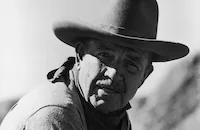In place of a legitimate narrative, Hawks offered John Wayne tearing after rhinos, zebras, elephants, and giraffes - all shot on location in the wilds of Tanganyika. Wayne and his co-stars go toe-to-toe with real live animals, chasing them down in suped-up trucks and wrangling them like displaced cowboys (albeit the kind that are costumed by Edith Head). Outside of that, the characters mostly just play cards, argue, and flirt with women, but the chase scenes seem to be enough for the picture’s many admirers.
Hatari! (it means “Danger!” in Swahili) was a much-needed hit for Wayne, and it still stands as one of the more realistic Hollywood films ever shot in Africa. All you need to do is watch John Huston’s The African Queen (1951) to see how badly rear projections and mismatched cutaways can corrupt the authenticity of a difficult location shoot. The audience benefits greatly from Hawks’ (and especially Wayne’s) genuine sense of adventure.
Wayne plays Sean Mercer, a macho game hunter who captures wild animals to sell to zoos around the world. Mercer’s manly-man crew consists of “Indian” (Bruce Cabot), “Pockets” (Red Buttons), and Kurt Mueller (Hardy Kruger), all of whom get a blast out of subduing beautiful creatures in their natural habitat. (Note: Wildlife fans may have trouble watching some of this.) The raging testosterone flow is interrupted, however, when a beautiful photographer named Anna Maria D’Allesandro (Elsa Martinelli) shows up to take some safari pictures. Sean develops an interest in Anna Maria, but can only show his affection by giving her a hard time for daring to be a woman.
And that’s about it. You certainly won’t lose the storyline if you decide to get up and make a sandwich, although you may miss John Wayne wrestling a giraffe.
Wayne was depressed while filming Hatari!, for several reasons. First and foremost, his dear friend, Ward Bond (who intended to make a cameo in the movie) died shortly before filming began. Wayne had even planned on performing an elaborate practical joke on Bond while he was in Africa. The goal was to get a clear photo of Bond’s rear end beside a rhino’s. Wayne would then make a poster featuring both posteriors, unveil it at drunken Hollywood parties, and have the revelers decide which beast had the biggest butt. One wonders what The Duke would have done had he not liked Bond.
Cousin Duke was rightfully livid, and had to perform as much spin control as he could from the far reaches of Africa. He took out trade paper ads stressing that no one involved in The Alamo supported Wills’ actions, ending his statement with “I refrain from using stronger language because I am sure his intentions were not as bad as his taste.” Wills did not win his Oscar, and was, in fact, made into a laughing stock by various comedians and industry types. He’s lucky Wayne was busy with that giraffe. He may have ended up in a cage himself.
Director: Howard Hawks
Producer: Howard Hawks
Screenplay: Leigh Brackett (based on a story by Harry Kurnitz)
Cinematography: Russell Harlan and Joseph Brun
Editing: Stuart Gilmore
Music: Henry Mancini
Art Design: Hal Pereira and Carl Anderson
Set Design: Sam Comer and Claude Carpenter
Stunts: Carey Loftin
Costumes: Edith Head
Principal Cast: John Wayne (Sean Mercer), Elsa Martinelli (Dallas), Hardy Kruger (Kurt), Gerard Blain (Chips), Red Buttons (Pockets), Michele Girardon (Brandy), Bruce Cabot (Indian), Valentin de Vargas (Luis).
C-159 min. Letterboxed. Closed captioning.
by Paul Tatara






















